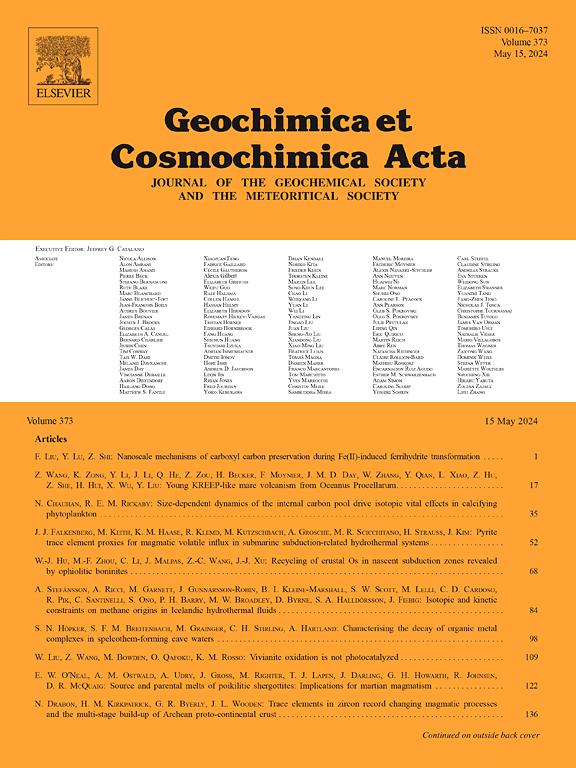Mineralogical and chronological records of strong shock metamorphism in pigeonite cumulate eucrite Northwest Africa 8326
IF 5
1区 地球科学
Q1 GEOCHEMISTRY & GEOPHYSICS
引用次数: 0
Abstract
Mineralogical records of strong shock metamorphism (around or above 20 GPa) are common in L-group chondrites, Martian meteorites, and lunar meteorites, but rarely reported in Howardite-Eucrite-Diogenite (HED) meteorites. Here, we report detailed mineralogical observations of shock-induced features and ion-microprobe merrillite U-Pb ages from the pigeonite cumulate eucrite Northwest Africa (NWA) 8326. Shock-induced mineralogical features in NWA 8326 contain: (i) planar fractures in pyroxene and partial maskelynitization of plagioclase; (ii) presence of high-pressure minerals such as tissintite, stishovite, vacancy-rich augite, super-silicic garnets within melt veins, and xieite, tuite, and reidite in the host rock outside melt veins. We also observed fine-grained clinoenstatite and pigeonite at the edges of shock melt and propose they formed through metastable crystallization. Our study indicates that NWA 8326 experienced shock metamorphism of at least 20 GPa, comparable to those observed in L-group chondrites, Martian meteorites, and lunar meteorites. We propose that the relatively low shock pressures inferred for shocked eucrites in previous investigations could be due to the absence of suitable high-pressure mineralogical indicators. The ion-microprobe 207Pb/206Pb age of merrillite in NWA 8326 is 4238 ± 32 Ma (95 % confidence) and represents the timing of the shock metamorphism. The similarity of the impact ages across NWA 8326, some eucrites, lunar samples/meteorites, and chondrites suggests that there were probably widespread impact events at ∼4.2 Ga in the Solar System.
西北非洲8326鸽质堆积长辉长岩强冲击变质作用的矿物学和年代学记录
强激波变质作用的矿物学记录(在20gpa左右或以上)在l群球粒陨石、火星陨石和月球陨石中很常见,但在howarite - eucite - diogenite (HED)陨石中很少报道。本文报道了西北非洲(NWA) 8326鸽质堆积长辉长岩的冲击诱发特征和离子探针镁铝石U-Pb年龄的详细矿物学观察。NWA 8326震源矿物学特征包括:(1)辉石面状断裂和斜长石部分掩斑化;(ii)熔体脉内存在组织辉石、辉石、富空辉石、超硅榴石等高压矿物,熔体脉外的寄主岩中存在叶石、辉石、辉石等高压矿物。我们还在激波熔体边缘观察到细粒斜辉石和鸽石,认为它们是通过亚稳结晶形成的。我们的研究表明,NWA 8326经历了至少20 GPa的激波变质作用,与l群球粒陨石、火星陨石和月球陨石所观察到的相当。我们认为,在以往的研究中,冲击长长岩的冲击压力相对较低,可能是由于缺乏合适的高压矿物学指标。NWA 8326银美林石的离子探针207Pb/206Pb年龄为4238±32 Ma(95%置信度),代表了冲击变质作用的时间。NWA 8326、一些长绿长岩、月球样本/陨石和球粒陨石的撞击年龄的相似性表明,在~ 4.2 Ga时,太阳系可能存在广泛的撞击事件。
本文章由计算机程序翻译,如有差异,请以英文原文为准。
求助全文
约1分钟内获得全文
求助全文
来源期刊

Geochimica et Cosmochimica Acta
地学-地球化学与地球物理
CiteScore
9.60
自引率
14.00%
发文量
437
审稿时长
6 months
期刊介绍:
Geochimica et Cosmochimica Acta publishes research papers in a wide range of subjects in terrestrial geochemistry, meteoritics, and planetary geochemistry. The scope of the journal includes:
1). Physical chemistry of gases, aqueous solutions, glasses, and crystalline solids
2). Igneous and metamorphic petrology
3). Chemical processes in the atmosphere, hydrosphere, biosphere, and lithosphere of the Earth
4). Organic geochemistry
5). Isotope geochemistry
6). Meteoritics and meteorite impacts
7). Lunar science; and
8). Planetary geochemistry.
 求助内容:
求助内容: 应助结果提醒方式:
应助结果提醒方式:


